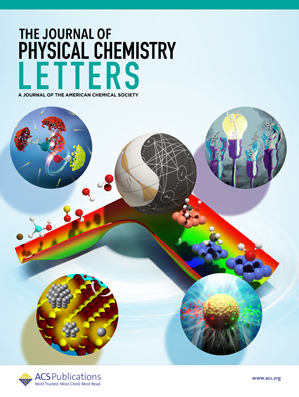Zero Phonon Line and Near-Infrared Luminescence in Cs4CdSb2–xCrxCl12 Quadruple-Layered Halide Double Perovskite
IF 4.8
2区 化学
Q2 CHEMISTRY, PHYSICAL
引用次数: 0
Abstract
There is growing interest in understanding the optoelectronic properties of inorganic lead-free layered halide double perovskites (LHDPs). Here, we report a distinctive sharp zero phonon line (ZPL) emission at 727 nm and an intense, broad near-infrared (NIR) emission at 757 nm from the photoluminescence (PL) spectra measured at temperatures below 217 K, resulting from Cr3+ substitution in Cs4CdSb2Cl12 LHDPs. Pristine Cs4CdSb2Cl12 exhibits only a weak and broad self-trapped excitonic emission centered around 590 nm. On the contrary, an NIR emission (fwhm = 72.5 nm) at 757 nm is also observed at 300 K in Cs4CdSb2–xCrxCl12 (x = 0.05 to 0.3) originating from the d–d transition of Cr3+ ions. This broad mode evolves into 2 distinct emissions: a ZPL (at 727 nm) and an intense, broad NIR (at 746 nm) sideband below 217 K. The ZPL originates from the spin-allowed 4T2g → 4A2g d–d transition from Cr3+. ZPL intensity increases with Cr3+ substitution. This study demonstrates the promising optical properties of Cr3+-substituted LHDPs, indicating their potential for future applications in optoelectronic devices.

求助全文
约1分钟内获得全文
求助全文
来源期刊

The Journal of Physical Chemistry Letters
CHEMISTRY, PHYSICAL-NANOSCIENCE & NANOTECHNOLOGY
CiteScore
9.60
自引率
7.00%
发文量
1519
审稿时长
1.6 months
期刊介绍:
The Journal of Physical Chemistry (JPC) Letters is devoted to reporting new and original experimental and theoretical basic research of interest to physical chemists, biophysical chemists, chemical physicists, physicists, material scientists, and engineers. An important criterion for acceptance is that the paper reports a significant scientific advance and/or physical insight such that rapid publication is essential. Two issues of JPC Letters are published each month.
 求助内容:
求助内容: 应助结果提醒方式:
应助结果提醒方式:


